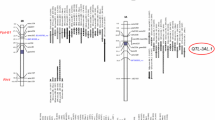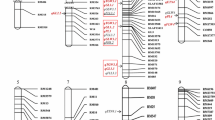Abstract
Two genetic linkage maps based on doubled haploid (DH) and recombinant inbred lines (RILs) populations, derived from the same indica-japonica cross ‘Samgang × Nagdong’, were constructed to analyze the quantitative trait loci (QTLs) affecting agronomic traits in rice. The segregations of agronomic traits in RILs population showed larger variations than those in DH population. A total of 10 and 12 QTLs were identified on six chromosomes using DH population and seven chromosomes using RILs population, respectively. Three stable QTLs including pl9.1, ph1.1, and gwp11.1 were detected through different years. The percentages of phenotypic variation explained by individual QTLs ranged from 8 to 18% in the DH population and 9 to 33% in the RILs population. Twenty-three epistatic QTLs were identified in the DH population, while 21 epistatic QTLs were detected in the RILs population. Epistatic interactions played an important role in controlling the agronomic traits genetically. Four significant main-effect QTLs were involved in the digenic interactions. Significant interactions between QTLs and environments (QE) were identified in two populations. The QTLs affecting grain weight per panicle (GWP) were more sensitive to the environmental changes. The comparison and QTLs analysis between two populations across different years should help rice breeders to comprehend the genetic mechanisms of quantitative traits and improve breeding programs in marker-assisted selection (MAS).
Similar content being viewed by others
References
Basten C, Weir BS, Zeng ZB. 1997. QTL Cartographer: a reference manual and tutorial for QTL mapping Bernardo R. 2008. Molecular markers and selection for complex traits in plants: learning from the last 20 years. Crop Sci. 48: 1649–1664
Cho YG, Eun MY, McCouch SR, Chae YA. 1994. The semi-dwarf gene, sd-1, of rice (Oryza sativa L.). II. Molecular mapping and marker-assisted selection. Theor. Appl. Genet. 89: 54–59
Cho YG, Kang HJ, Lee JS, Lee YT, Lim SJ, Gauch H, Eun MY, McCouch SR. 2007. Identification of quantitative trait loci in rice for yield, yield components, and agronomic traits across years and locations. Crop Sci. 47: 2403–2417
He P, Li JZ, Zheng XW, Shen LS, Lu CF, Chen Y, Zhu LH. 2001. Comparison of molecular linkage maps and agro nomic trait loci between DH and RIL populations derived from the same rice cross. Crop Sci. 41: 1240–1246
Hittalmani S, Huang N, Courtois B, Venuprasad R, Shashidhar HE, Zhuang JY, Zheng KL, Liu GF, Wang GC, Sidhu SJ, Srivantaneeyakul S et al.. 2003. Identification of QTL for growth- and grain yield-related traits in rice across nine locations of Asia. Theor. Appl. Genet. 107: 679–690
Hittalmani S, Shashidhar HE, Bagali PG, Huang N, Sidhu JS, Singh VP, Khush GS. 2002. Molecular mapping of quantitative trait loci for plant growth, yield and yield related traits across three diverse locations in a doubled haploid rice population. Euphytica 125: 207–214
Ishimaru K, Yano M, Aoki N, Ono K, Hirose T, Lin SY, Monna L, Sasaki T, Ohsugi R. 2001. Toward the mapping of physiological and agronomic characters on a rice function map: QTL analysis and comparison between QTLs and expressed sequence tags. Theor. Appl. Genet. 102: 793–800
Kobayashi S, Fukuta Y, Sato T, Osaki M, Khush GS. 2003. Molecular marker dissection of rice (Oryza sativa L.) plant architecture under temperate and tropical climates. Theor. Appl. Genet. 107: 1350–1356
Lander ES, Green P, Abrahamson J, Barlow A, Daly MJ, Lincoln SE, Newberg LA. 1987. MAPMAKER: an inter active computer package for constructing primary genetic linkage maps of experimental and natural populations. Genomics 1: 174–181
Lee SJ, Oh CS, Suh JP, McCouch SR, Ahn SN. 2005. Identification of QTLs for domestication-related and agro nomic traits in an Oryza sativa × O. rufipogon BC1F7 population. Plant Breed. 124: 209–219
Li XY, Qian Q, Fu ZM, Wang YH, Xiong GS, Zeng DL, et al. 2003a. Control of tillering in rice. Nature 422: 618–621
Li ZK, Pinson SR, Park WD, Paterson AH, Stansel JW. 1997. Epistasis for three grain yield components in rice (Oryza sativa L.). Genetics 145: 453–465
Li ZK, Yu SB, Lafitte HR, Huang N, Courtois B, et al. 2003b. QTL × environment interactions in rice. I. Heading date and plant height. Theoretical and Applied Genetics 108: 141–153
Liang F, Deng Q, Wang Y, Xiong Y, Jin D, Li J, Wang B. 2004. Molecular marker-assisted selection for yield-enhancing genes in the progeny of “9311 × O. rufipogon ” using SSR. Euphytica 139: 159–165
Lincoln S, Daley M, Lander E. 1992. Constructing genetic maps with MAPMAKER /EXP 3.0. Whitehead Institute Technical Report, 3rd Ed. Whitehead Institue, Cambridge, Mass
Lu C, Shen L, Tan Z, Xu Y, He P, Chen Y, Zhu L. 1996. Comparative mapping of QTLs for agronomic traits of rice across environments using a doubled haploid population. Theor. Appl. Genet. 93: 1211–1217
Marri P, Sarla N, Reddy L, Siddiq E. 2005. Identification and mapping of yield and yield related QTLs from an Indian accession of Oryza rufipogon. BMC Genet. 6: 33
McCouch SR, Doerge RW. 1995. QTL mapping in rice. Trends Genet. 11: 482–487
McCouch SR, Kochert G, Yu ZH, Wang ZY, Khush GS, Coffman WR, Tanksley SD. 1988. Molecular mapping of rice chromosomes. Theor. Appl. Genet. 76: 815–829
Mei HW, Li ZK, Shu QY, Guo LB, Wang YP, Yu XQ, Ying CS, Luo LJ. 2005. Gene actions of QTLs affecting several agronomic traits resolved in a recombinant inbred rice population and two backcross populations. Theor. Appl. Genet. 110: 649–659
Paterson AH, Lander ES, Hewitt JD, Peterson S, Lincoln SE, Tanksley SD. 1988. Resolution of quantitative traits into Mendelian factors by using a complete linkage map of restriction fragment length polymorphisms. Nature 335:721–726
Qiao YL, Jiang WZ, Rahman ML, Chu SH, Piao R, Han LZ, Koh HJ. 2008. Comparison of molecular linkage maps and QTLs for morphological traits in two reciprocal backcross populations of rice. Mol.Cells 25: 417–427
Qin Y, Kim S-M, Sohn J-K. 2008. Detection of main-effect QTLs, epistatic QTLs and QE interactions for grain Appearance of brown rice (Oryza sativa L.). J. Crop Sci. Biotech. 2: 151–156
Rahman ML, Chu SH, Choi M, Li Qiao Y, Jiang W, Piao R, Khanam S, Cho Y, Jeung J, Jena KK. 2007. Identification of QTLs for some agronomic traits in rice using an intro gression line from Oryza minuta. Mol. Cells 24: 16–26
Ribaut J-M, Hoisington D. 1998. Marker-assisted selection: new tools and strategies. Trends Plant Sci. 3: 236–239
Septiningsih EM, Prasetiyono J, Lubis E, Tai TH, Tjubaryat T, Moeljopawiro S, McCouch SR. 2003. Identification of quantitative trait loci for yield and yield components in an advanced backcross population derived from the Oryza sativa variety IR64 and the wild relative O. rufipogon. Theor. Appl. Genet. 107: 1419–1432
Shan J-X, Zhu M-Z, Shi M, Gao J-P, Lin H-X. 2009. Fine mapping and candidate gene analysis of spd6, responsible for small panicle and dwarfness in wild rice (Oryza rufi pogon Griff.). Theor. Appl. Genet. 119: 827–836
Thomson MJ, Tai TH, McClung AM, Lai XH, Hinga ME, Lobos KB, Xu Y, Martinez CP, McCouch SR. 2003. Mapping quantitative trait loci for yield, yield components and morphological traits in an advanced backcross population between Oryza rufipogon and the Oryza sativa cultivar Jefferson. Theor. Appl. Genet. 107: 479–493
Wang DL, Zhu J, Li ZKL, Paterson AH. 1999. Mapping QTLs with epistatic effects and QTL × environment interactions by mixed linear model approaches. Theor. Appl. Genet. 99: 1255–1264
Xiao J, Li J, Grandillo S, Ahn SN, Yuan L, Tanksley SD, McCouch SR. 1998. Identification of trait-improving quantitative trait loci alleles from a wild rice relative, Oryza rufipogon. Genetics 150: 899–909
Xiao J, Li J, Yuan LP, Tanksley SD. 1996. Identification of QTLs affecting traits of agronomic importance in a recombinant inbred population derived from a subspecific rice cross. Theor. Appl. Genet. 92: 230–244
Xing Y, Tan Y, Hua J, Sun X, Xu C, Zhang Q. 2002. Characterization of the main effects, epistatic effects and their environmental interactions of QTLs on the genetic basis of yield traits in rice. Theor. Appl. Genet. 105: 248–257
Xu Y, Zhu L, Xiao J, Huang N, McCouch SR. 1997. Chromosomal regions associated with segregation distortion of molecular markers in F2, backcross, doubled haploid, and recombinant inbred populations in rice (Oryza sativa L.). Mol.Gen. Genet. 253: 535–545
Xue WY, Xing YZ, Weng XY, Zhao Y, Tang WJ, Wang L, Zhou HJ, Yu SB, Xu CG, Li XH, Zhang QF. 2008. Natural variation in Ghd7 is an important regulator of heading date and yield potential in rice. Nat. Genet. 40: 761–767
Yamamoto T, Kuboki Y, Lin SY, Sasaki T, Yano M. 1998. Fine mapping of quantitative trait loci Hd-1, Hd-2 and Hd-3, controlling heading date of rice, as single Mendelian factors. Theor. Appl. Genet. 97: 37–44
Yan JQ, Zhu J, He CX, Benmoussa M, Wu P. 1999. Molecular marker-assisted dissection of genotype × environment interaction for plant type traits in rice (Oryza sati va L.). Crop Sci. 39: 538–544
Yano M. 2001. Genetic and molecular dissection of naturally occurring variation. Curr. Opin. Plant Biol. 4: 130–135
Yano M, Kojima S, Takahashi Y, Lin H, Sasaki T. 2001. Genetic control of flowering time in rice, a short-day plant. Plant Physiol. 127: 1425–1429
Yoon DB, Kang KH, Kim HJ, Ju HG, Kwon SJ, Suh JP, Jeong OY, Ahn SN. 2006. Mapping quantitative trait loci for yield components and morphological traits in an advanced backcross population between Oryza grandiglu mis and the O. sativa japonica cultivar Hwaseongbyeo. Theor. Appl. Genet. 112: 1052–1062
You A, Lu X, Jin H, Ren X, Liu K, Yang G, Yang H, Zhu L, He G. 2006. Identification of quantitative trait loci across recombinant inbred lines and testcross populations for traits of agronomic importance in rice. Genetics 172: 1287–1300
Yuan PR, Kim HJ, Chen QH, Ju HG, Lee SJ, Ji SD, Ahn SN. 2009. QTL dissection of agronomic and domestication traits using introgression lines carrying wild rice (Oryza rufipogon Griff.) segments in cultivated rice (O. sativa L.) background. J. Crop Sci. Biotech. 12: 241–248
Zhang Y, Luo L, Xu C, Zhang Q, Xing Y. 2006. Quantitative trait loci for panicle size, heading date and plant height co segregating in trait-performance derived near-isogenic lines of rice (Oryza sativa). Theor. Appl. Genet. 113: 361–368
Zhuang JY, Fan YY, Rao ZM, Wu JL, Xia YW, Zheng KL. 2002. Analysis on additive effects and additive-by-additive epistatic effects of QTLs for yield traits in a recombinant inbred line population of rice. Theor. Appl. Genet. 105: 1137–1145
Zhuang JY, Lin HX, Lu J, Qian HR, Hittalmani S, Huang N, Zheng KL. 1997. Analysis of QTL × environment interaction for yield components and plant height in rice. Theor. Appl. Genet. 95: 799–808
Author information
Authors and Affiliations
Corresponding author
Rights and permissions
About this article
Cite this article
Zhao, X., Qin, Y., Jia, B. et al. Comparison and analysis of main effects, epistatic effects, and QTL × environment interactions of QTLs for agronomic traits using DH and RILs populations in rice. J. Crop Sci. Biotechnol. 13, 235–241 (2010). https://doi.org/10.1007/s12892-010-0076-x
Received:
Accepted:
Published:
Issue Date:
DOI: https://doi.org/10.1007/s12892-010-0076-x




